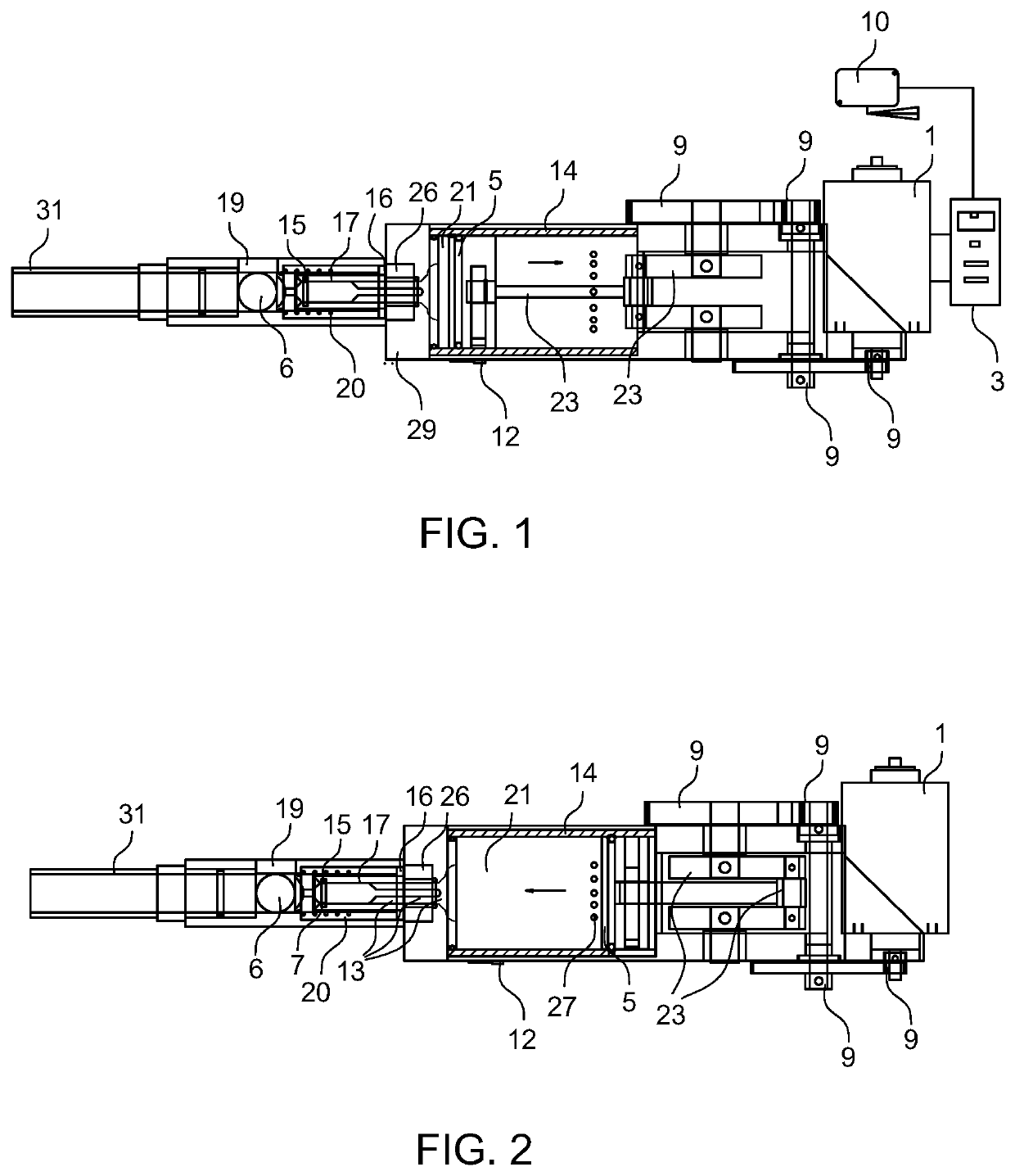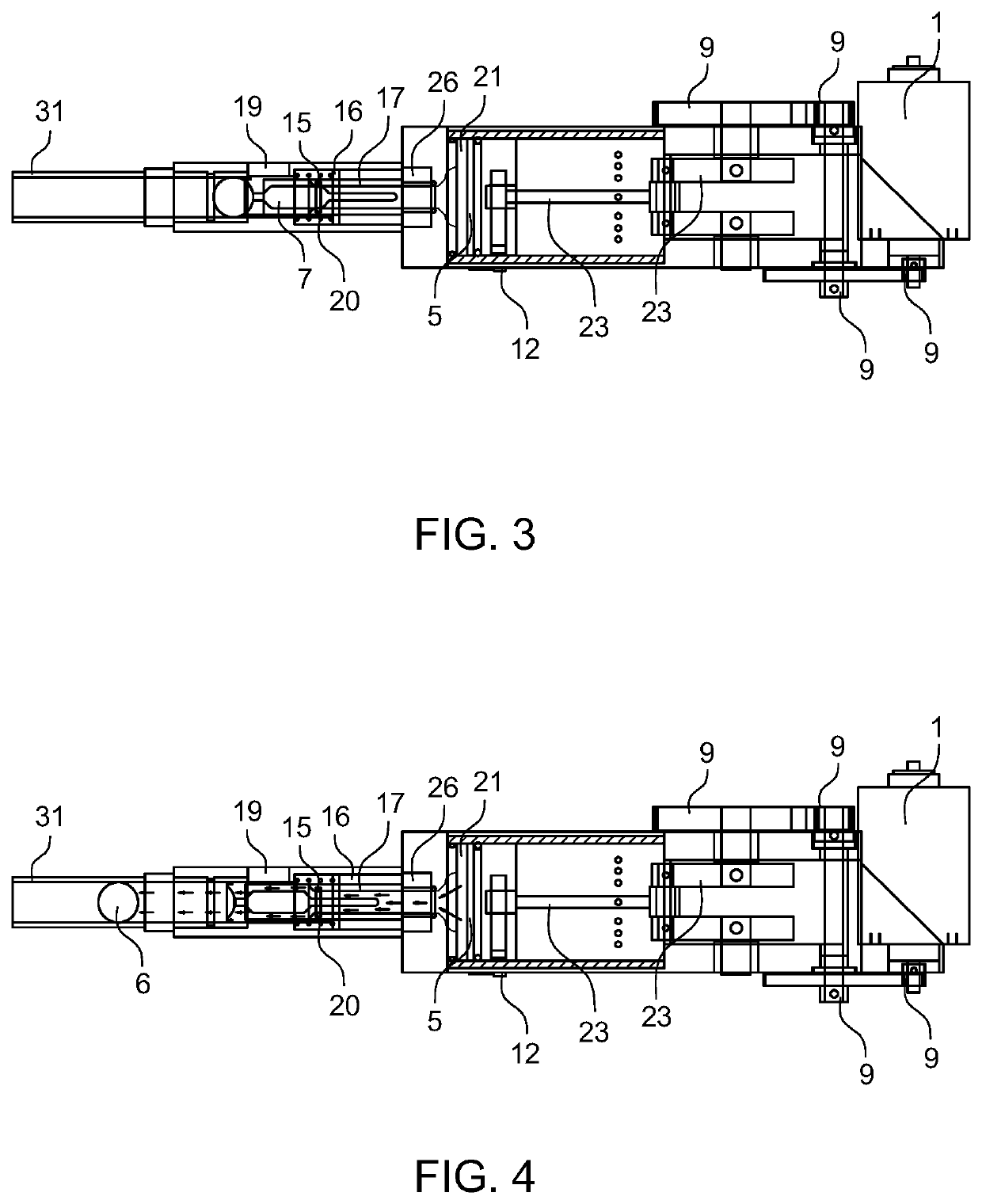Specifically, the valve and bolt actuation heretofore disclosed in these methods have distinct disadvantages when compared to the present disclosure.
This implementation suffers from limitations inherent in the spring piston systems.
Springs in such systems are highly stressed mechanical elements that are prone to breakage and which increase the weight of the air gun.
A further disadvantage of Hu's teaching is that the spring is cocked via a rack and pinion mechanism and the spring is released from the rack pinion under full load, causing the tips of the gear teeth to undergo severe tip loading.
This causes high stress and wear on the mechanism, especially the gear teeth.
This is the major complaint for those guns in the commercial market and is a major reliability issue with this style mechanism.
A further disadvantage of this type of mechanism is that upon scaling up (to accept larger projectiles or projectiles with more energy), there occurs a significant increase in the wear and forward recoil both of which lead to unacceptable reliability and performance.
In a dry fire (no projectile), the mechanism can be damaged as the piston slams against the face of the cylinder.
Thus, forward recoil, high wear and low power are drawbacks in these types of mechanisms.
In this case, the device is for non-portable operation.
If the valve is opened before the breech is sealed, the projectile is pushed off of the bolt and air can blow out through the breech, and efficiency is reduced.
Additionally, the bolt and breech shown in these patents have long strokes on the bolts which severely limit the open time of the breech for projectile feeding.
This requires use of a powered feeder, which adds to the complexity of the unit and, in the case of a passive feeder, generally limits the firing speed to about 4 balls per second.
This is a significant restriction and can limit the application to lower firing rate guns or necessitate the use of a feeder.
Additionally, as can be seen in the specification, such systems are complex and must be carefully designed to avoid a pinch point when the bolt crossed and closes the breech opening.
Although this is an improvement by allowing more time in the open breech condition and thus improving the rate of fire, it substantially increases the complexity of the mechanism and thereby its cost.
Furthermore again the cam drive can create a safety issue if the bolt is closed using the cam as a pinch point is created between the breech and the moving bolt.
While this solves the obvious problem of manually pumping a chamber up in order to fire a gun and is a simple implementation, these devices are incapable of generating sufficient energy to fire anything but low energy projectiles.
Solenoids are inefficient devices and can only convert very limited amounts of energy due to their operation.
This limits the ability of the solenoid to store energy in the air stream to a very short time period and further relegates its use to low energy air rifles.
This results in a very energetic piston mass similar to that shown in spring piston designs and further results in the undesirable double recoil effect as the piston mass must come to a halt.
Additionally, this technique suffers from dry-fire in that the air is compressed between the piston and the projectile.
A missing projectile allows the air to communicate to the atmosphere through the barrel and can damage the mechanism in a dry-fire scenario.
Although this solves the issue of sufficient power, it is no longer considered an air rifle as it becomes a combustion driven gun.
Moreover, it suffers from the aforementioned disadvantages including complexity and difficulty in controlling the firing sequence.
Although this solves the issue of double recoil, it is not suitable to a portable system due to inefficiencies of compressing air and the large tank volume required.
Using air in this fashion is inefficient and not suitable for portable operation since much of the air compression energy is lost to the environment through the air tank via cooling.
Furthermore, additional complexity and expense is required to regulate the air pressure from the tank so that the projectile velocity is repeat ably controlled.
Again, due to the large volume of air between the compression means and the projectile, much of the heat of compression is lost leading to inefficient operation.
Additionally, this patent teaches of a continuously operating device, which suffers from a significant lock time (time between trigger pull and projectile leaving the barrel) as well as the inability to run in a semiautomatic or single shot mode.
Further disadvantages of this device include the pulsating characteristics of the air stream which are caused by the release and reseating of the check valve during normal operation.
Limitations of this approach include difficulty in achieving high projectile velocity since the transfer of energy must be done extremely rapidly between the impacting hammer and the projectile.
Further limitations include the need to absorb a significant impact as the solenoid plunger must stop and return for the next projectile.
Since the solenoid plunger represents a significant fraction of the moving mass (i.e. it often exceeds the projectile weight), this type of system is very inefficient and limited to low velocity, low energy air guns as may be found in toys and the like.
The spring is “cocked” via an electric motor, but again, this does not overcome the prior mentioned limitations.
All of the currently available devices suffer from one or more of the following disadvantages: Manual operation by cocking a spring or pumping up an air chamber.
Difficult to selectively perform single fire, semiautomatic, burst or automatic modes.
Inconvenience, safety and consistency issues associated with refilling, transport and use of high-pressure gas or carbon dioxide cylinders.
Non-portability and low efficiency which are associated with compressed air supplied from a typical air compressor.
Forward recoil effects, high wear, and dry fire damage associated with spring piston and electrically actuated spring piston designs.
Complicated mechanisms associated with electrically winding and releasing a spring piston design resulting in expensive mechanisms with reliability issues.
Inefficient use and / or coupling of the compressed air to the projectile resulting in low energy projectiles and large energy input requirements.
Safety issues associated with pinch points and limited cyclic rates due to slow bolt speeds.
 Login to View More
Login to View More  Login to View More
Login to View More 


